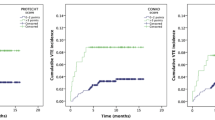Abstract
Purpose
Recently, a clinical prediction rule for recurrent venous thromboembolism (VTE) in cancer patients, named Ottawa score, was derived to individualize treatments with different intensities. It is composed of four variables including sex, primary tumor site, tumor stage, and prior history of VTE. The objective of this study was to validate the Ottawa score in an independent patient population in a tertiary hospital in Korea.
Methods
Medical records of consecutive adult patients (>18 years) with active malignancy and newly diagnosed VTE from January 1, 2006 to December 31, 2010 were analyzed. Using the same definition of predictor variables in the original derivation study, patients were divided into low (score ≤0) and high (score ≥1) risk groups for recurrent VTE, and their actual recurrence rate were analyzed.
Results
Of the 546 patients with newly diagnosed VTE, 99 (18.1 %) had recurrent VTE during the follow-up period. In the low-risk group, 34 (13.2 %) had recurrence, compared to 65 (22.4 %) in the high-risk group. Ottawa score’s performance showed 66 % sensitivity, 50 % specificity, 22 % positive predictive value, and 87 % negative predictive value in our validation cohort.
Conclusion
We were not able to accurately ascertain the relevance of the Ottawa score in our validation cohort. Future validation studies, including a more diverse patient population with different cancer predominance, are warranted.

Similar content being viewed by others
References
Blom JW, Doggen CJ, Osanto S, Rosendaal FR (2005) Malignancies, prothrombotic mutations, and the risk of venous thrombosis. JAMA 293:715–722
Silverstein MD, Heit JA, Mohr DN, Petterson TM, O’Fallon WM, Melton LJ 3rd (1998) Trends in the incidence of deep vein thrombosis and pulmonary embolism: a 25-year population-based study. Arch Intern Med 158:585–593
Chew HK, Wun T, Harvey D, Zhou H, White RH (2006) Incidence of venous thromboembolism and its effect on survival among patients with common cancers. Arch Intern Med 166:458–464
Sorensen HT, Mellemkjaer L, Olsen JH, Baron JA (2000) Prognosis of cancers associated with venous thromboembolism. N Engl J Med 343:1846–1850
Prandoni P, Lensing AW, Piccioli A, Bernardi E, Simioni P, Girolami B, Marchiori A, Sabbion P, Prins MH, Noventa F, Girolami A (2002) Recurrent venous thromboembolism and bleeding complications during anticoagulant treatment in patients with cancer and venous thrombosis. Blood 100:3484–3488
Wells PS (2001) Outpatient treatment of patients with deep-vein thrombosis or pulmonary embolism. Curr Opin Pulm Med 7:360–364
Wells PS, Kovacs MJ, Bormanis J, Forgie MA, Goudie D, Morrow B, Kovacs J (1998) Expanding eligibility for outpatient treatment of deep venous thrombosis and pulmonary embolism with low-molecular-weight heparin: a comparison of patient self-injection with homecare injection. Arch Intern Med 158:1809–1812
Hull RD, Pineo GF, Brant RF, Mah AF, Burke N, Dear R, Wong T, Cook R, Solymoss S, Poon MC, Raskob G (2006) Long-term low-molecular-weight heparin versus usual care in proximal-vein thrombosis patients with cancer. Am J Med 119:1062–1072
Deitcher SR, Kessler CM, Merli G, Rigas JR, Lyons RM, Fareed J (2006) Secondary prevention of venous thromboembolic events in patients with active cancer: enoxaparin alone versus initial enoxaparin followed by warfarin for a 180-day period. Clin Appl Thromb Hemost 12:389–396
Lee AY, Levine MN, Baker RI, Bowden C, Kakkar AK, Prins M, Rickles FR, Julian JA, Haley S, Kovacs MJ, Gent M (2003) Low-molecular-weight heparin versus a coumarin for the prevention of recurrent venous thromboembolism in patients with cancer. N Engl J Med 349:146–153
Meyer G, Marjanovic Z, Valcke J, Lorcerie B, Gruel Y, Solal-Celigny P, Le Maignan C, Extra JM, Cottu P, Farge D (2002) Comparison of low-molecular-weight heparin and warfarin for the secondary prevention of venous thromboembolism in patients with cancer: a randomized controlled study. Arch Intern Med 162:1729–1735
Hull RD, Pineo GF, Brant RF, Mah AF, Burke N, Dear R, Wong T, Cook R, Solymoss S, Poon MC, Raskob G (2007) Self-managed long-term low-molecular-weight heparin therapy: the balance of benefits and harms. Am J Med 120:72–82
Louzada ML, Carrier M, Lazo-Langner A, Dao V, Kovacs MJ, Ramsay TO, Rodger MA, Zhang J, Lee AY, Meyer G, Wells PS (2012) Development of a clinical prediction rule for risk stratification of recurrent venous thromboembolism in patients with cancer-associated venous thromboembolism. Circulation 126:448–454
Monreal M, Zacharski L, Jimenez JA, Roncales J, Vilaseca B (2004) Fixed-dose low-molecular-weight heparin for secondary prevention of venous thromboembolism in patients with disseminated cancer: a prospective cohort study. J Thromb Haemost 2:1311–1315
Trujillo-Santos J, Nieto JA, Tiberio G, Piccioli A, Di Micco P, Prandoni P, Monreal M (2008) Predicting recurrences or major bleeding in cancer patients with venous thromboembolism. Findings from the RIETE Registry. Thromb Haemost 100:435–439
Lee J, Demissie K, Lu SE, Rhoads GG (2007) Cancer incidence among Korean-American immigrants in the United States and native Koreans in South Korea. Cancer Control 14:78–85
Louzada ML, Majeed H, Dao V, Wells PS (2011) Risk of recurrent venous thromboembolism according to malignancy characteristics in patients with cancer-associated thrombosis: a systematic review of observational and intervention studies. Blood Coagul Fibrinolysis 22:86–91
Acknowledgements
We thank Jin Ahn, NP, for her assistance in English language.
Conflict of interest
None
Author information
Authors and Affiliations
Corresponding author
Rights and permissions
About this article
Cite this article
Ahn, S., Lim, K.S., Lee, YS. et al. Validation of the clinical prediction rule for recurrent venous thromboembolism in cancer patients: the Ottawa score. Support Care Cancer 21, 2309–2313 (2013). https://doi.org/10.1007/s00520-013-1792-9
Received:
Accepted:
Published:
Issue Date:
DOI: https://doi.org/10.1007/s00520-013-1792-9




